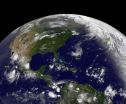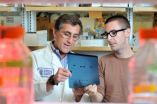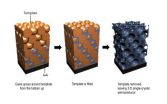(Press-News.org) An international team of astronomers led by the California Institute of Technology and involving the University of Colorado Boulder has discovered the largest and farthest reservoir of water ever detected in the universe.
The distant quasar is one of the most powerful known objects in the universe and has an energy output of 1,000 trillion suns -- about 65,000 times that of the Milky Way galaxy. The quasar's power comes from matter spiraling into the central supermassive black hole, estimated at some 20 billion times the mass of our sun, said study leader Matt Bradford of Caltech and NASA's Jet Propulsion Laboratory in Pasadena, Calif.
Because the quasar -- essentially a voraciously feeding black hole -- is so far away, its light has taken 12 billion light years to arrive at Earth. Since one light year equals about 6 trillion miles, the observations reveal a time when the universe was very young, perhaps only 1.6 billion years old. Astronomers believe the universe was formed by the Big Bang roughly 13.6 billion years ago.
The water measured in the quasar is in the form of vapor and is the largest mass of water ever found, according to the researchers. The amount of water estimated to be in the quasar is at least 100,000 times the mass of the sun, equivalent to 34 billion times the mass of the Earth.
In an astronomical context, water is a trace gas, but it indicates gas that is unusually warm and dense, said Bradford. "In this case, the water measurement shows that the gas is under the influence of the growing black hole, bathed in both infrared and X-ray radiation," he said.
"These findings are very exciting," said CU-Boulder Associate Professor Jason Glenn, a study co-author. "We not only detected water in the farthest reaches of the universe, but enough to fill Earth's oceans more than 100 trillion times."
The water measurement, together with measurements of other molecules in the vapor source, suggests there is enough gas present for the black hole to grow to about six times its already massive size, said Bradford. Whether it will grow to this size is not clear, however, as some of the gas may end up forming stars instead, or be ejected from the quasar host galaxy in an outflow.
In the Milky Way, the mass of gaseous water is at least 4,000 times smaller than that in the quasar, in part because most of the water in our own galaxy is frozen into ice. While the water vapor in the Milky Way is found only in a limited number of regions, a few light years in size or smaller, the water in the distant quasar appears to be distributed over hundreds of light years, said the researchers.
The discovery was made with a spectrograph called Z-Spec operating in the millimeter wavelengths -- found between the infrared and microwave wavelengths -- at the Caltech Submillimeter Observatory, a 10-meter telescope near the summit of Mauna Kea, on the big island of Hawaii. Z-Spec's detectors are cooled to within 0.06 degrees Celsius of absolute zero in order to obtain the exquisite sensitivity required for these measurements.
"Breakthroughs are coming fast in millimeter and submillimeter technology, enabling us to study ancient galaxies caught in the act of forming stars and supermassive black holes," said CU-Boulder's Glenn, who is a co-principal investigator on the Z-Spec instrument development and a fellow at CU-Boulder's Center for Astrophysics and Space Astronomy. "The excellent sensitivity of Z-Spec and similar technology will allow astronomers to continue to make important and surprising findings related to distant celestial objects in the early universe, with implications for how our own Milky Way galaxy formed."
Confirmation for this important discovery came from images obtained by the Combined Array for Research in Millimeter-Wave Astronomy, or CARMA, a sensitive array of radio dishes located in the Inyo Mountains of Southern California. The distant quasar under study is named APM 08279+5255.
The discovery highlights the utility of the millimeter and submillimeter band for astronomy, which has developed rapidly in the last two to three decades. To achieve the potential of this relatively new spectral range, astronomers, including the study authors, are now designing CCAT, a 25-meter telescope for the high Chilean Atacama desert. With CCAT astronomers will discover some of the earliest galaxies in the universe, and will be able to study their gas content via measurements of water as well as other important gas species, Glenn said.
INFORMATION:
In addition to Caltech, JPL and CU-Boulder, the Z-Spec collaboration includes the Institute of Space and Astronautical Science in Japan, the Observatories of the Carnegie Institute of Science and the University of Pennsylvania. Funding for Z-Spec was provided by the National Science Foundation, NASA, the Research Corporation and partner institutions.
The Caltech Submillimeter Observatory is operated under a contract from the National Science Foundation. CARMA was built and is operated by a consortium of universities with funding from a combination of state and private sources, as well as the National Science Foundation and its University Radio Observatory program.
Farthest, largest water mass in universe discovered
International study involves Caltech, University of Colorado Boulder
2011-07-25
ELSE PRESS RELEASES FROM THIS DATE:
Shining a light on the elusive 'blackbody' of energy research
2011-07-25
CHESTNUT HILL, MA (July 22, 2011) – A designer metamaterial has shown it can engineer emitted "blackbody" radiation with an efficiency beyond the natural limits imposed by the material's temperature, a team of researchers led by Boston College physicist Willie Padilla report in the current edition of Physical Review Letters.
A "blackbody" object represents a theorized ideal of performance for a material that perfectly absorbs all radiation to strike it and also emits energy based on the material's temperature. According to this blackbody law, the energy absorbed is equal ...
Life scientists use novel technique to produce genetic map for African Americans
2011-07-25
UCLA life scientists and colleagues have produced one of the first high-resolution genetic maps for African American populations. A genetic map reveals the precise locations across the genome where DNA from a person's father and mother have been stitched together through a biological process called "recombination." This process results in new genetic combinations that are then passed on to the person's children.
The new map will help disease geneticists working to map genetic diseases in African Americans because it provides a more accurate understanding of recombination ...
Cellular stress can induce yeast to promote prion formation
2011-07-25
It's a chicken and egg question. Where do the infectious protein particles called prions come from? Essentially clumps of misfolded proteins, prions cause neurodegenerative disorders, such as mad cow/Creutzfeld-Jakob disease, in humans and animals. Prions trigger the misfolding and aggregation of their properly folded protein counterparts, but they usually need some kind of "seed" to get started.
Biochemists at Emory University School of Medicine have identified a yeast protein called Lsb2 that can promote spontaneous prion formation. This unstable, short-lived protein ...
NASA catches 3 tropical cyclones at 1 time
2011-07-25
It's not often that a satellite can capture an image of more than one tropical cyclone, but the GOES-13 satellite managed to get 3 tropical cyclones in two ocean basins in one image today. Bret and his "sister" Cindy are racing through the North Atlantic, while another area tries to develop far to their south. "Cousin" Dora is still a hurricane in the eastern Pacific.
In infrared image taken on July 22 at 0845 UTC (4:45 a.m. EDT), GOES-13 captured Tropical Depression Bret, Tropical Storm Cindy in the north Atlantic and low pressure area associated with a tropical wave ...
Northwest Forest Plan has unintended benefit – carbon sequestration
2011-07-25
CORVALLIS, Ore. – The Northwest Forest Plan enacted in 1993 was designed to conserve old-growth forests and protect species such as the northern spotted owl, but researchers conclude in a new study that it had another powerful and unintended consequence – increased carbon sequestration on public lands.
When forest harvest levels fell 82 percent on public forest lands in the years after passage of this act, they became a significant carbon "sink" for the first time in decades, absorbing much more carbon from the atmosphere than they released. At the same time, private ...
New target found for nitric oxide's attack on salmonella bacteria
2011-07-25
A new target for nitric oxide has been revealed in studies of how it inhibits the growth of Salmonella. This bacterium is a common cause of food-poisoning.
"Nitric oxide is naturally produced in the nose and the gut and other tissues in the body to ward off infection," explained the senior author of the paper, Dr. Ferric Fang. He is a University of Washington (UW) professor of laboratory medicine, microbiology and medicine.
Nitric oxide – not to be confused with nitrous oxide, the laughing gas in dentists' offices – is similar to the preservatives in hotdogs, Fang ...
2 genetic variations predict second cancers after radiation for children with Hodgkin lymphoma
2011-07-25
A genome-wide association study published in the August issue of Nature Medicine has found two tiny genetic variations that can predict which patients with Hodgkin's lymphoma are most likely to develop radiation-induced second cancers years after treatment. Knowing in advance who is at risk could help physicians tailor treatment to reduce the risks for patients who are most susceptible to long-term damage.
Hodgkin's lymphoma is one of the most treatable cancers, with more than 90 percent of patients surviving after a combination of radiation and chemotherapy. But nearly ...
Graphene's 'quantum leap' takes electronics a step closer
2011-07-25
Writing in the journal Nature Physics, the academics, who discovered the world's thinnest material at The University of Manchester in 2004, have revealed more about its electronic properties.
Research institutes and universities around the world are already looking at ways to build devices such as touch-screens, ultrafast transistors and photodetectors.
Now the research from the creators of the material promises to accelerate that research, and potentially open up countless more electronic opportunities.
The researchers, from the universities of Manchester, Madrid ...
Pocket chemistry: DNA helps glucose meters measure more than sugar
2011-07-25
CHAMPAIGN, Ill. — Glucose meters aren't just for diabetics anymore. Thanks to University of Illinois chemists, they can be used as simple, portable, inexpensive meters for a number of target molecules in blood, serum, water or food.
Chemistry professor Yi Lu and postdoctoral researcher Yu Xiang published their findings in the journal Nature Chemistry.
"The advantages of our method are high portability, low cost, wide availability and quantitative detection of a broad range of targets in medical diagnostics and environmental monitoring," Lu said. "Anyone could use it ...
New photonic crystals have both electronic and optical properties
2011-07-25
CHAMPAIGN, Ill. — In an advance that could open new avenues for solar cells, lasers, metamaterials and more, researchers at the University of Illinois have demonstrated the first optoelectronically active 3-D photonic crystal.
"We've discovered a way to change the three-dimensional structure of a well-established semiconductor material to enable new optical properties while maintaining its very attractive electrical properties," said Paul Braun, a professor of materials science and engineering and of chemistry who led the research effort.
The team published its advance ...
LAST 30 PRESS RELEASES:
UVA’s Jundong Li wins ICDM’S 2025 Tao Li Award for data mining, machine learning
UVA’s low-power, high-performance computer power player Mircea Stan earns National Academy of Inventors fellowship
Not playing by the rules: USU researcher explores filamentous algae dynamics in rivers
Do our body clocks influence our risk of dementia?
Anthropologists offer new evidence of bipedalism in long-debated fossil discovery
Safer receipt paper from wood
Dosage-sensitive genes suggest no whole-genome duplications in ancestral angiosperm
First ancient human herpesvirus genomes document their deep history with humans
Why Some Bacteria Survive Antibiotics and How to Stop Them - New study reveals that bacteria can survive antibiotic treatment through two fundamentally different “shutdown modes”
UCLA study links scar healing to dangerous placenta condition
CHANGE-seq-BE finds off-target changes in the genome from base editors
The Journal of Nuclear Medicine Ahead-of-Print Tip Sheet: January 2, 2026
Delayed or absent first dose of measles, mumps, and rubella vaccination
Trends in US preterm birth rates by household income and race and ethnicity
Study identifies potential biomarker linked to progression and brain inflammation in multiple sclerosis
Many mothers in Norway do not show up for postnatal check-ups
Researchers want to find out why quick clay is so unstable
Superradiant spins show teamwork at the quantum scale
Cleveland Clinic Research links tumor bacteria to immunotherapy resistance in head and neck cancer
First Editorial of 2026: Resisting AI slop
Joint ground- and space-based observations reveal Saturn-mass rogue planet
Inheritable genetic variant offers protection against blood cancer risk and progression
Pigs settled Pacific islands alongside early human voyagers
A Coral reef’s daily pulse reshapes microbes in surrounding waters
EAST Tokamak experiments exceed plasma density limit, offering new approach to fusion ignition
Groundbreaking discovery reveals Africa’s oldest cremation pyre and complex ritual practices
First breathing ‘lung-on-chip’ developed using genetically identical cells
How people moved pigs across the Pacific
Interaction of climate change and human activity and its impact on plant diversity in Qinghai-Tibet plateau
From addressing uncertainty to national strategy: an interpretation of Professor Lim Siong Guan’s views
[Press-News.org] Farthest, largest water mass in universe discoveredInternational study involves Caltech, University of Colorado Boulder






